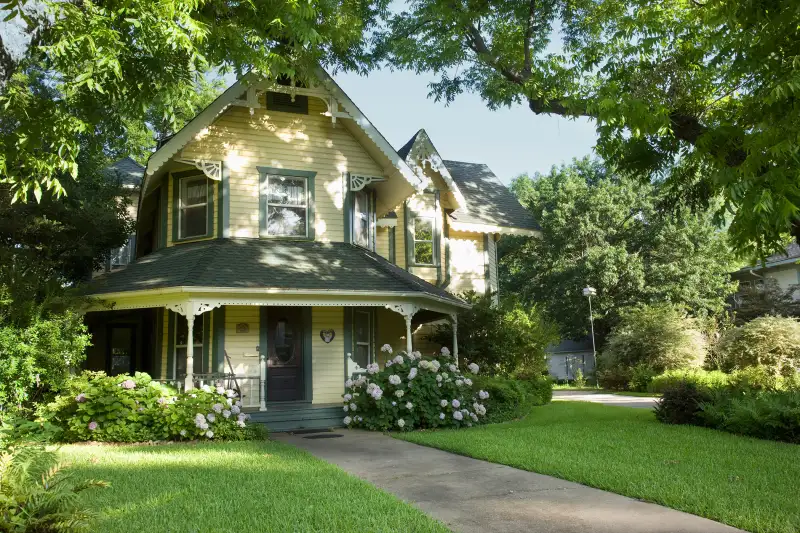3 Money-Smart Ways to Boost Your Home's Curb Appeal

Just as every mother believes her son is a handsome devil, we homeowners tend to see the best in our houses—or at least we become comfortably familiar with the way they look.
But let’s face it, to the objective eye, not every man is George Clooney and not every house is a Frank Lloyd Wright masterpiece. There are a lot of drab, even downright gloomy façades out there, especially among homes that were built shortly after World War II, when many builders abandoned traditional architectural styling to streamline costs and mass-produce housing.
Thankfully, the cosmetic surgery required to put a beautiful face on your home doesn’t require a big-ticket construction job. “Creating curb appeal isn’t about trying to transform the house from a plain-Jane ranch into a grand Victorian,” says Charlotte, Vt., architect Ted Montgomery. “Just changing one or two little details is all it takes.” It’s an investment that will boost your home pride, endear you to the neighbors, and generate a lot more interest from buyers someday.
To find inspiration, you can hire an architect (about $100 an hour) to offer ideas and maybe sketch a plan (expect these to take a few hours each). Or look at similar homes in your area while keeping the following strategies in mind.
Subtract Flaws
Assuming the house and yard are already well maintained, job one is to get rid of blemishes left by a penny-pinching builder or the misguided efforts of previous owners:
Replace the garage doors. The most prominent facial feature of many homes is a pair of big garage doors, which all too often are flat, lackluster slabs of steel or vinyl. Trade them for more visually appealing doors with moldings, windows, or an old-fashioned carriage-house look ($3,000 to $8,000 a door, including labor). See DesignerDoors and ClopayDoor for examples.
Remove siding. Sometimes ugliness is only skin deep. “Peek under dreary aluminum, vinyl, or asbestos siding and you may find well-preserved wood clapboards,” says Asheville, N.C., architect Jane Mathews. If so, remove the siding, repair the old wood, and give the house an attractive paint job ($10,000 to $20,000). If not, you could paint the siding or replace it with fiber cement siding, a no-maintenance product that looks like real wood ($15,000 to $25,000).
Lose the funky railings. Swap out bad porch or stoop railings, such as black iron bars or chunky pressure-treated decking components, for visually interesting banisters and spindles that are worthy of their prominent placement ($1,000 to $10,000).
Add Character
Like a dimple or a cleft chin, the addition of an interesting architectural element can give your house some distinctiveness.
Install a salvaged door. The typical post- war front door is decidedly dull, but the entry should be your home’s focal point, says Corvallis, Ore., architect Lori Stephens. For interesting replacements, look in an architectural salvage yard (see page 26). Consider a recycled mission-style oak door, a six-panel Colonial with blown-glass windows, or arch top French doors ($400 to $1,600; more if you’re converting a standard opening to an arch top).
Add moldings. Many newer homes lack exterior trim; the siding just butts up against the windows and doors. A contractor can give the house a more sophisticated, traditional look by cutting back that siding and slipping in wide, flat moldings around the openings and possibly at the corners of the house and between its stories ($3,000 to $4,000). It’s best to use a synthetic product like cellular PVC for your new moldings, since it looks like wood but will never rot.
Enhance the roof. A straight, unadorned roofline makes a house look about as interesting as a shipping container. So consider adding windowed dormers (a.k.a. gabled peaks) or extending the eaves (the roof overhangs) a few feet beyond the front of the house with detailed moldings on the underside ($2,500 to $10,000 per dormer or eaves extension). This is major surgery, though; do not attempt it without first getting an architect’s input.
Enhance the Effect
Invasive procedures aren’t always necessary. Just adding the right accents can transform your home’s outer look—not unlike a pair of stylish new specs or a good haircut.
Replace light fixtures and hardware. Lose generic shiny brass or black house numbers and mailbox and porch lights (especially bare-bulb fixtures) and substitute something unique and substantial, perhaps made of antiqued copper, bronze, or brushed nickel. For ideas, see Rejuvenation and Restoration Hardware.
Plan for a nonstop flower show. Most of the flowers in your yard probably bloom in the late spring, which makes for a beautiful May—or whenever the big show happens in your climate—but leaves you with a bland yard for the other 10 or 11 months of the year. A local nursery can help you choose and plant additional bulbs, shrubs, and trees with different bloom times (as well as plants with colorful autumn foliage and winter berries), so there will always be something performing ($50 to $250 a shrub, $500 to $1,500 a tree).
Add color. A paint job ($2,000 to $10,000) in pleasing hues can make any structure appealing. “But don’t choose a bright, high-contrast color scheme—that only exaggerates a house’s flaws,” Montgomery warns. For subtler suggestions, check out the book House Colors by Susan Hershman ($26 at Amazon) or go for the colors of nature—muted greens, deep reds, and pale yellows—and keep the body and trim close in color. That will give your home a friendly, peaceful look rather than make it say, “Hey, look at me!” Sort of like an average-looking guy choosing a simple charcoal suit instead of a flashy powder-blue one that only a Hollywood star could pull off.
For more on money-smart home upgrades, check out The Money Guide to Home Improvements, available on newsstands June 12.
